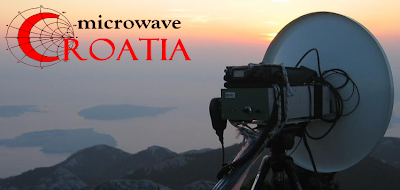This is just another simple beacon for 6cm band that came out as a result of raining afternoon and a desk full of various microwave components. Of course, this can be done on many different ways but I choose to use the parts that are cheap and available to every microwave builder. As most of my designs this project is also modular where every component can be replaced with some other, resulting maybe better, maybe worst performance but at the end the output signal level will be within the range of a few dB of difference.
This is a block diagram of the beacon oscillator from my scrapbook. After so many simple project I start to take a notes with at least few measurements so If I need these data later, they are always here in the notebook. Th PC is nice but notebook is better.
So no detail electrical diagram this time because all blocks are explained already through my previous designs. The beacon is built around well known S53MV crystal oscillator used in his beacons or ZIF microwave radios. The 720MHz signal is attenuated to a level of approx. 5dBm to drive more efficiently the 6cm multiplier explained on my blog. As we are dealing with the multiplying factor of 8, not much of the signal is left at the required frequency of 5760 MHz. This signal is amplified with a two MMICs blocks, the first one withe the NLB-310 and the second one with the SNA-586. The output power is around 10dBm or 10mW. The filter is optional, but recommended, reducing the output power to 8dbm+
Going from the left, the 720MHz oscillator (still not screened) is starting with the 20MHz crystal. This is a common value where also cheap computer grade crystals can work. There is a tuning inductor and trimmer capacitor with possibility to tune desired frequency, in my case at the beginning of the band, but leaving enough room for EME operators. after the multiplying chain (x3 x3 x2 x2) we end up with decent level of 11dbm+ for the next stage.
Maximum allowed input level for the multiplier is +10dbm, so attenuator was required in between. Playing with the attenuator values I found that the 6db attenuator will give the best results, higher output of the multiplier for the 8x multiplying factor.
The multiplier was driven with the 5dBm of the signal for the best performance. Even better results are possible by changing the value of the bias resistor in the first MMIC multiplier stage. Usually higher resistor value will give up to 3dB better output signal for desired input frequency. I did not play with that in this project, so there is room for improvement. I got -9dBm of signal after the multiplier.
MMIC blocks are simple and cheap and they have a decent gain. I choose the two different MMICs to see how they perform at 6GHz. The first one with NLB-310 is working very nice with the 11dB of the gain producing almost +2dBm of the signal. The second one, SNA-586 gives another push to +10dBm with the gain of just litle bite more than 8dB on 6 GHz.
The filter is optional but can be very useful if you plan to use this beacon on remote high location. 3/4 pipe cap filter can be the easiest solution. Just tune the filter to maximum signal and this is enough. Place the filter between the MMICs to isolate them with the I.L. of the filter. After initial attempt my pipe cap filter was inserting 4dB of loss, a bit high. Then after fine tuning I was able to reduce the I.L. to only 1.6dB @ 5760MHz. Inserting the filter the output drops to +8dBm.
The last component (gray)that can be seen is directional coupler. This is not a part of the beacon oscillator. It was used just to simultaneously monitor the signal on the frequency counter and the spectrum analyzer.
This is the core of the 6cm beacon. The rest of the parts that are required are beacon keyer, power supply and the antenna. The keyer is already explained on the blog, where multiplier stage should be keyed with the positive voltage. Power supply can be anything that can give you 500mA @ 13,6V. The antenna type depend on the requirement, simple horn or slotted waveguide can be a solution or if you want to go really cheap and simple, a simple vertical Wi-Fi 5.7GHz band can be good also but vertical polarization will produce less signal for H-pol weak signal users. For a home use, this is the best-buy option.



.JPG)
.JPG)
.JPG)
Hi! Do you have a PCB ?? Tnx from IK5CON Riccardo info@ik5con.it
ReplyDelete